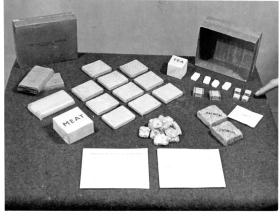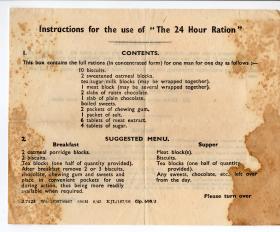The 24 Hour Ration was a direct successor to the Mess Tin Ration (48 Hour), which was first issued for the invasion of North Africa. Whilst the Mess Tin Ration served its purpose, it was deemed too heavy and too bulky in proportion to its nutritional value. Therefore, after experimentation and research, it was deemed that a compact, lightweight ration was needed. Two different designs of the ration were put through an arduous 10 day trial, one designed by the War Office and the other designed by the Dietetic Advisor to the Chief of Combined Operations. Elements of both were deemed to be best, so these were incorporated into a new design and this resulted in the 24 Hour Ration.
Due to it being intended to be used as an assault or landing ration (or if special circumstances dictated, a sea passage ration), it was designed to provide the highest possible ratio of food value in the smallest possible space and weight.
All contents were dried and wrapped in a waxed paper which was heat-sealed and the box itself being waxed cardboard, which eliminated the need to rely on tinplate, also allowing the contents to be both waterproof and gas-proof. It’s one of the big myths of the pack that it contained tins, it never did. One of the big learning's from previous rations was that circular tins meant waste space, so it one of the key design features had to be that the contents must be “square” to fit tightly into the box with minimal space lost. The final product provided 4,000 calories and fitted into a space less than 90 cubic inches and weighing 35 ounces.
Once the design had been finalized, the War Office placed an order for 7½ Million of these rations, to be ready in 9 months. The problem with this was that the ration was completely new and unconventional, involving new production methods being set up by companies. Firms who had previously made compressed soup, turned their hands to making the meat block and salt makers turned their hands to making the tea-milk-sugar blocks. By a massive effort, the production was completed by 31st March 1944, just in time for the D-Day preparations.
The complete standard box, with contents were designed be fitted into the larger half of the mess tin. For operations where it was deemed it would be more than 24 hours, two packs would be issued, one to be fitted inside the larger half of the mess tin and the other split and distributed on the individual. Alongside this, the individual was also issued a folding stove, fuel tablets and a flat tin of 20 cigarettes with a hinged lid. There was also an Assault 24 Hour Ration, which was issued to seaborne assault troops on D-Day, which was slightly smaller in size, but its contents were identical. This was designed to fit inside the smaller half of the mess tin to keep the contents dry and stop the contents becoming contaminated in the event of a gas attack.
Along with its use on D-Day, the ration was also used for Operation Dragoon, Operation Market-Garden and Operation Varsity.
Source:
Written by Ramsey Green.
Read More






Latest Comments
There are currently no comments for this content.
Add Comment
In order to add comments you must be registered with ParaData.
If you are currently a ParaData member please login.
If you are not currently a ParaData member but wish to get involved please register.